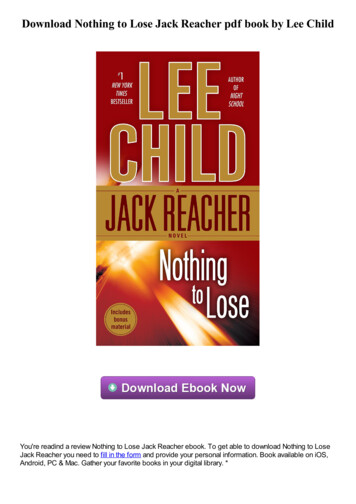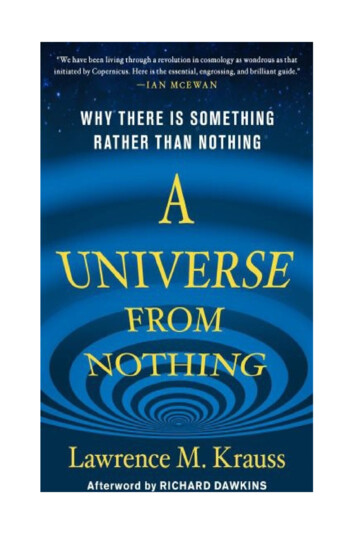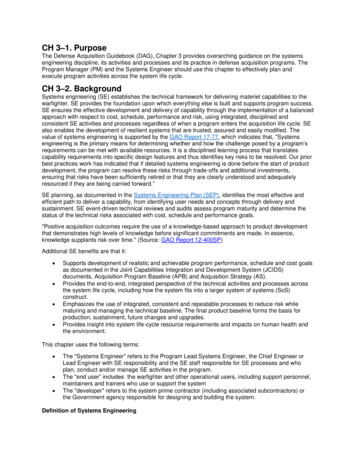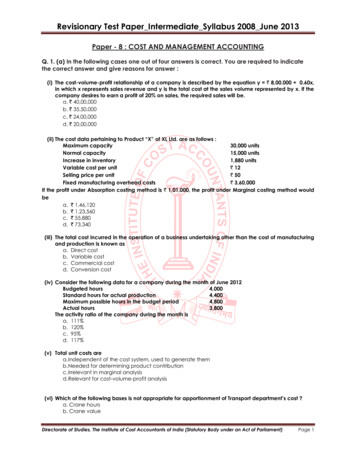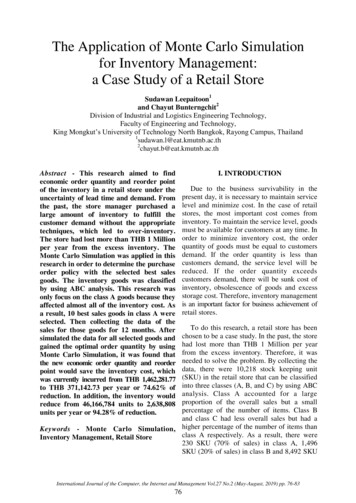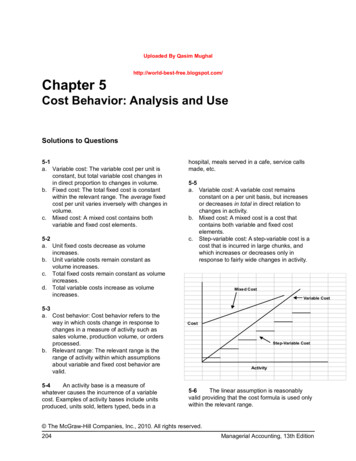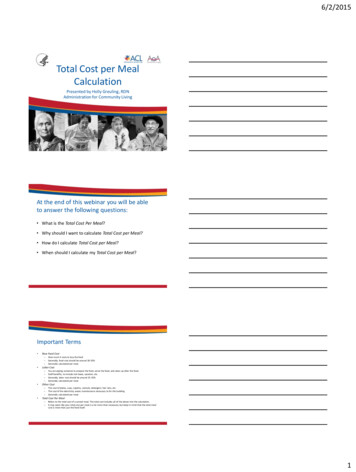
Transcription
6‘Knowledge cost ya nothingand is not heavy to carryaround’: Taungurung bushtucker, bush medicineand bushcraftUncle Roy held a deep respect for both his grandparents, but a specialbond with his grandmother gave him authority as a Taungurung Elderand teacher. At the end of her life, Lizzie Edmond Patterson entrustedyoung Roy with spiritual custodianship:On the 12th of February 1950, when I was 9½ years old, dadcame and picked me up out of school and took me down to mygrandparents’ place. Grandfather grabbed me and took me into thebedroom where Nanna was. She was still in bed, and grandfatherput me in the bed beside my grandmother. She put her arms aroundme, and I put my arm around her, and my grandfather went tothe other side of the room. I don’t know how long I was there,but after a while grandfather come over and took Nanna’s arm offme and took my arm off her and walked me outside. He give meto my mother, and then walked back into the bedroom. A littlewhile later he said ‘he’s got his grandmother’s spirit’. Nanna told97
On Taungurung Landme about respect, and when she died she gave me her spirit. Thatwas quite a few days ago now. I am proud of it and she is still theretoday; she is still there within me and she guides me.1This responsibility or mantle, passed from grandmother to grandchild,undergirded Uncle Roy’s desire to teach Taungurung history and culture.After our initial meetings, Uncle Roy commented:I think first we better go up to that bush tucker mob and spendsome time up there, so you can actually taste it and feel it firsthand;this is going to open up your eyes darl, I mean it. You see, peoplethink, ‘Oh, that’s only a weed’, but you wait until you taste thatweed, it is unreal. I’m goin’ to talk about the bush tucker, whichI learnt through my grandmother and grandfather mainly. I wasn’tvery old when it started up, only about 4 or 5 years old.2Uncle Roy makes the important point that plants growing ‘wild’ in thebush might be mistaken as weeds by the uninformed, but this misnamingdoes not affect the importance of the plant as tucker. Defining what is or isnot a weed is culturally contingent; human–plant interactions are directlyinfluenced by social conceptualisations of vegetation.3 Since invasion, theattitudes of European settlers to indigenous vegetation has been shaped byutilitarian, psychological and aesthetic considerations.4 A preference foropen country, neatly tilled fields and familiar European species influencedwhat Tom Griffiths has described as ‘century-scale vegetation change’in Australia.5 When Uncle Roy saw introduced species like poplars andwillows growing uncontrolled in the bush, he commented that Europeansbrought them over to Australia so that they could feel more at home.He asked: ‘Why didn’t they just stay at home and appreciate themover there?’1234598Roy Patterson, in conversation with Jennifer Jones, 3 March 2016, DS3001137.Roy Patterson, in conversation with Jennifer Jones, 3 March 2016, DS3001139.Head and Atchison, ‘Cultural Ecology’.Bonyhady, The Colonial Earth, 78.Griffiths, ‘How Many Trees’, 375.
6. ‘Knowledge cost ya nothing and is not heavy to carry around’Uncle Roy PattersonSource: Photographed by Moorina Bonini.European attitudes to foraging were also shaped by historic perceptionsthat sedentary agriculture was progressive and advanced, while huntergatherer societies were unproblematically viewed as backward orprimitive.6 From this perspective, systematic Aboriginal travel commonlydescribed by the term ‘walkabout’ was seen as aimless wandering ratherthan purposeful, systematised and sustainable travel around Country thatenabled seasonal management of grains and food plants.7 As Indigenousenvironmental management strategies and systems were not consideredto be ‘farming’, they were dismissed, and existing flora was seen as‘an impediment rather than a resource’. Indigenous plants were removedand replaced in a process described as ‘improvement’.8 Contemporarynon-Indigenous Australian attitudes to plants could be understoodas overlaying ancient and continuing Indigenous Australian culturalrelationships with food and medical vegetation. Uncle Roy wanted hisreaders to become sensitive to this context, recognising that developmentof respectful attitudes will benefit the coexistence of Aboriginal andnon‑Aboriginal people on the lands they share.678Yen, ‘The Domestication of Environment’.Kneebone, ‘Interpreting Traditional Culture’; Pascoe, Dark Emu.Griffiths, ‘How Many Trees’, 378.99
On Taungurung LandThe first step towards achieving this understanding was to get into the bush,visiting specific local places at the right time and with the right attitude.Uncle Roy’s approach to teaching and learning was process and relationshiporiented, rather than focused on an endpoint or outcome.9 He took MoorinaBonini, our photographer, and me onto Country so that our learning wasexperiential and built upon what we already knew. He was always askingus, ‘So, what do you want to know?’, and helping us to contextualise newexperiences by connecting past with present and future.We set out to our classroom in the rolling hills, river flats and roadsidescrub. The stories Uncle Roy shared about bush tucker and bush medicinewere intergenerational, emerging from long family relationships withparticular places:10On Friday night me grandmother and grandfather come andpicked me up from home in the horse and dray. They had a big bluedraught horse whose name was Jess. Grandfather never had to hither or nothing; he’d just say ‘shake a leg Jess’ and she’d get intoa trot. They’d take me down to their place at the end of McGretton’sRoad in Healesville, and then next day me grandfather and I’d goout with the old tea-tree pole with a piece of string, makin out thatwe are fishin’, and me grandfather is teachin’ me. A man cannotteach a woman or a girl, and a woman can’t teach a man or a boy;that is our law. That’s how I learnt my culture and my Dreamtime,about the spirit world and our law; with me Granddad.11As I accompanied Uncle Roy onto Taungurung Country for the first time,he explained that these gender restrictions did not apply to me, becauseI am non-Aboriginal. I was certainly aware that I was a rookie. Percheduncomfortably in a new university 4WD, I thought I was creepingalong the tracks, concentrating on the potholes, when Uncle Roy wouldinterrupt with an urgent ‘slow down, slow down’. Hardly 100 metres pastthe last cleared paddock, and we were already surrounded by bush tuckerand bush medicine.Uncle Roy came alive in the bush. Alert and attentive, he identifieddistant specimens for us to find and examine. We were in and out ofthe car to note the form and texture of plants, to crush, smell and taste.9Acton et al., ‘Conversations on Cultural Sustainability’.10 Tuck, McKenzie and McCoy, ‘Land Education’, 8.11 Roy Patterson, in conversation with Jennifer Jones, 3 March 2016, DS3001139.100
6. ‘Knowledge cost ya nothing and is not heavy to carry around’Uncle Roy’s spirit was tireless, but he still had to drag his body in and outof the vehicle. ‘Come on you bugger’, he would say as he heaved his leftleg back into the car again. Moorina and I tried to help, but our effortswere not always welcome.One time, Uncle Roy spotted the fresh new leaves of a gum tree, up highin a clearing. We headed up the track and pulled the 4WD in as close aspossible. It was difficult terrain. Uncle Roy was out of the car in a flash,and soon tumbling down the hill. Thankfully, an embankment of leavesand bark buffered his fall. Moorina and I were still in shock, as Uncle Roywas brushing dirt from his trousers. Back on task, he looked nonplussedand then annoyed as we fussed over him. He had taken harder falls in hislife and wanted us to focus on the next lesson. He continued:Everything you eat is medicine in our bush tucker; we healourselves with what we eat. You can’t get nothing better than that.You watch the birds and the animals; what they eat, you can eat.We’ve got medicine to cure the colds and flu, and it is so simple,it is too easy; but the Europeans have found out about some of ourmedicine and they are strippin’ the trees of it and we get nothingfor it. It is our traditional knowledge; most of your medicine in thechemist shop has come from Indigenous knowledge. People say,‘these are only plants!’ but they are our food and medicine.12Bush medicine makes use of plants that are abundant in the everydaycontexts. Such knowledge has the potential to connect local communitiesto their natural environments, and to promote respect for localIndigenous people.13In this chapter, Uncle Roy talks about bush medicines that treat a rangeof ailments, including colds, sore muscles, wounds, headaches and rashes.Uncle Roy treated people in the Taggerty district who came to him forcures. This was his contribution to reconciliation processes:I do smoking ceremonies for cleansing your spirit. I don’t carewhat colour skin you got; you’ve got an inner spirit. The smokingis to cleanse and ease the pain of the hurt within the inner spirit.It doesn’t cure it, but it does make it easier to live with the hurt.I’ve got three people that come up every year for smoking. One of1213Roy Patterson, in conversation with Jennifer Jones, 15 April 2016, DS300143.Ralph-Flint, ‘Cultural Borrowing’.101
On Taungurung Landthem is an American lady who sent me a letter from America whenher mother was dying; she asked me to send a smoking over. I facednorth-west and blew the smoke that way. About a month later, shecome home and said she could smell the eucalyptus, and whenshe smelt that, she saw her mother relax; then she died peacefully.14Uncle Roy viewed ‘medical pluralism’, or the integration of traditionalmedical practices with biomedical healthcare, as essential to the preservationof Taungurung culture. Improvements in Indigenous and non-Indigenoushealth and wellbeing come through connection to Country and culture.15Bush tucker and bush medicine provide a site where ‘Indigenous andnon-Indigenous worlds of knowledge and experience’ can intersect forthe benefit of both people and Country.16Animals also provide Taungurung people and newcomers withguidance in our shared environment. Not all views of the world are secularand/or functional, and Uncle Roy wanted to communicate Taungurungunderstandings that non-human species and their environments shouldbe held with loving regard:17The Dreaming comes into everything, our dancing andcorroboree, our walkabout, every part of our lives. My totem is thecrow; he is a messenger. The koala, he don’t drink water; so we goto the koala to get permission to get good water on our walkabout.If we don’t ask for permission, we get bad water. That way, we livein the Dreamtime world as a part of daily life; I still live it today.When I am teaching, I am teaching my Dreaming and through theDreaming we learn the ways of Mother Earth, the ways of Bunjiland the ways of our people.18Uncle Roy’s relationship with Bunjil the eagle had an ecological dimension.Bleakley explained this by noting that human–animal relationshipsprovide ‘a focus for a wider explicit sympathy with the world at large’.19Uncle Roy understood that there is a continuity between humans, animalsand the world:141516171819102Roy Patterson, in conversation with Jennifer Jones, 3 March 2016, DS3001137.Oliver, ‘The Role of Traditional Medicine’.Nakata, ‘Pathways for Indigenous Education’.Rose, ‘Love in the Time of Extinctions’, 83.Roy Patterson, in conversation with Jennifer Jones, 15 April 2016, DS300142.Bleakley, ‘Animals and Information’, 132.
6. ‘Knowledge cost ya nothing and is not heavy to carry around’Bunjil is the creator, Bunjil gave life to Mother Earth, to floraand fauna. Bunjil gave us bush tucker, bush medicine and our wayof life. They are a beautiful animal and the creator that made usin our Dreamtime. That is why I am so proud of them.When I go to the Healesville Sanctuary to watch the birds ofprey, Bunjil comes up behind me and talks to me, especially oneyoung female eagle. She will not shut up. She is a beautiful bird;I’ve got one of her feathers at home. The male eagle was shot bythe farmer; the wildlife people had to go up and put him outof his misery. When I die, the feathers go to me grandchildren.The feathers carry Bunjil’s spirit.One bloke at the Healesville Sanctuary says to me, ‘Uncle, thisone Bunjil never stops watchin’ you all the time you’re with me’.I can rub me hand up and down her chest and she is lovin’ it.He says, ‘I’ve never seen her do that’. He said, ‘why do you reckonthat is Uncle?’ I said, ‘the spirit of the Aboriginal people’. He says,‘you are probably right’.20Uncle Roy held deep sympathy for Bunjil and their suffering under theimpact of colonisation. He observed the eagle’s management of a changeddiet, and the spiritual haven that both eagle and Aboriginal people findat Camp Jungai:Whenever an eagle eats rabbit, dead sheep, dead cattle, whatever,the fur goes in down their throat and they get a fur ball. Every nowand again they cough the fur ball up. They go down to a specialtree at Camp Jungai down by the Rubicon River where they coughup. I do believe when they cough up their fur ball, they coughup part of their spirit and you can actually feel that spirit and thepower of it down around those trees. I’ve had Elders come downfrom New South Wales and Queensland, and I’ve taken themdown there, and they didn’t know our culture or nothing, but theysat down on the ground there and they never moved. They spendthe whole day there because they could feel the spirit. I feel it everytime I go down there. In fact, I feel Bunjil every time I come up toCamp Jungai. This is a very spiritual place.212021Roy Patterson, in conversation with Jennifer Jones, 3 March 2016, DS3001139.Roy Patterson, in conversation with Jennifer Jones, 29 April 2016, DS300148–53.103
On Taungurung LandCamp Jungai is an ancestral ceremonial site that has been an outdooreducation camp since the 1970s. It remains an important place of refuge,cultural maintenance and recuperation. Several of our bush tuckerjourneys started or ended at Camp Jungai, as important plant specimensare nurtured there by Taungurung people and camp employees. Providingnon-Indigenous people with access to cultural education at Camp Jungaialso enables custodians to foster respect:Respect for our culture, respect for bush tucker, bush medicineand the spirit world. The Dreaming starts at birth and when youstart to walk around, you start to learn. It goes through your wholelife. The children are always watchin’, and this is how they learn.22Below is Uncle Roy’s account of Taungurung culture as he understoodit. Uncle Roy wanted to record, preserve and promote this generationalknowledge. He makes plain that access to foods and medicines, and theirpreparation and sharing was determined by customary law and madesafe by generational supervision. Readers are advised to exercise cautionand asked to show respect for Taungurung intellectual property whenengaging with natural resources.Blackwood wattle (Acacia melanoxylon)I’m going to give you some leaves and we will find some water,and you are going make soap. It is marvellous. What you do is takethe leaves and make a ball out of it. Put your hands under water towet them and then rub together hard and fast until the suds come.It has its own perfume and is your skin moisturiser and healingsubstance for dermatitis. Grab the leaves and rub them togetherin water and it will make soap. The leaves of the blackwood wattleor the inner bark of the blackwood wattle. All you do is put bothyour hands in the water with the leaves and pull them out andrub hard and fast and it will go frothy. If you rub long enough,it will take the dye out of the leaves and the soap will go free.You can smell the perfume in it and your hands are so soft, it isunreal; absolutely beautiful. The trouble is that they have all beencut down around here.22104Roy Patterson, in conversation with Jennifer Jones, 3 March 2016, DS3001138.
6. ‘Knowledge cost ya nothing and is not heavy to carry around’Blackwood wattleSource: Photographed by Moorina Bonini.Blackwood wattle soapSource: Photographed by Moorina Bonini.105
On Taungurung LandWell, you can also take the seeds out of the seedpods and grindthem down to make a flour. You can use it in damper, scones andcakes, or make a drink out of it and it tastes very similar to coffee.You can use the seed in ice cream or mix it with your food for extraflavouring.23Bogong mothsCathedral here has the Bogong moth, oh yeah, in the spring,September–October, the ground is covered with them! Up at CampJungai, the kids say, ‘Uncle Roy, what are these things?’ I say, ‘Theyare moths, you can eat them!’, ‘Urgh!’ they say. Aboriginal peoplecooked them. They put a small stick through the moth, hold it overthe fire for a few minutes, then pull him out and eat him; tastesa little bit nutty. They used to cook ’em up and when they wentwalkabout they had them in a bag and ate ’em cold and kept onwalkin’. They never went hungry.24Bottle brushWith the bottle brush, you grab the plant between the thumband forefinger, and lick the honey off the flower, or you put it inyour mouth and suck it off. They got natural honey in them. Everytime you see a bird or a bee going to a bottle brush, you can takethe honey off it too.25Bracken fern (Pteridium esculentum)While the bracken fern is little on the end you can eat them;just pick them off. They are light and tender and have a nutty taste,beautiful.These are food plants, but the bracken fern is also good for bullant and jump jack bites as well; they are mean nasty ones whenthey sting ya! Just rub it straight on the sting and within secondsit goes away.232425106Roy Patterson, in conversation with Jennifer Jones, 15 April 2016, DS300143.Roy Patterson, in conversation with Jennifer Jones, 8–9 November 2016, DS300158–66.Roy Patterson, in conversation with Jennifer Jones, 29 May 2016, DS300148–53.
6. ‘Knowledge cost ya nothing and is not heavy to carry around’Bracken fernSource: Photographed by Moorina Bonini.My grandfather taught me about the bracken fern; put it in thewater and wait for the fish to come to the top because it takesthe oxygen out of the water and they come up to the top for theoxygen and ‘bang, thank you’ you’ve got them. You never tooknothing that you didn’t need.26BurrSee this burr; if you get diarrhoea or gastro, you wash it andchew it and swallow the juice; chew and chew and chew until thereis nothing left of the juice and then throw it out. Within 24 hours,your diarrhoea or gastro will be cured. Look how it grows here,I’ve got it everywhere at home in Taggerty.272627Roy Patterson, in conversation with Jennifer Jones, 12 July 2016, DS300154–56.Roy Patterson, in conversation with Jennifer Jones, 8–9 November 2016, DS300158–66.107
On Taungurung LandBurrSource: Photographed by Moorina Bonini.Buxton gum (Eucalyptus crenulata)Buxton gumSource: Photographed by Moorina Bonini.108
6. ‘Knowledge cost ya nothing and is not heavy to carry around’The Buxton gum is a rare and endangered tree found on the alluvial flatsof the Acheron River near Buxton. It is a distinctive small tree of irregularform, growing to 12 metres high. The bark of the mature tree is rough overmost of the lower trunk, but smooth on the upper trunk and branches.The leaves are blue-green in colour and retain distinctive juvenile-typefoliage throughout its life.28 The leaf looks dry until you crush it, thenit becomes shiny and sticky, releasing very strong fragrance:The daughter of a friend of mine had whooping cough, andwhen she got rid of that, she got a chest infection. So, I gotsome Aboriginal medicine called Buxton gum. The Buxton gumis only grown in this area, and it’s a medicine that my ancestorsused. Europeans have been destroying that tree for years. To useit naturally you grate it up, wrap it in material, warm the materialup and wrap it around your neck; not too tight, so the warmthof the material goes into your neck and the vapour of the Buxtongum goes up into your nose and all the way down into your lungs.This young Indigenous fella said to me the other day, ‘that goesright through the bloody house Uncle Roy!’ I said, ‘that’s good,take some more leaf home, keep on doin’ it. If you are runnin’short, come up and git some more. This will heal ya’. I said, ‘keepit up a week or two and it will cure whatever infection you’ve gotin your throat’. Grab a leaf, screw it up, put it to you nose andbreathe in deep. This is where you get the original Vicks VapoRubfrom! But Vicks VapoRub ain’t as good as the natural thing. In thesummertime, it is an insect repellent. It is a natural medicine; we’vebeen using it 50,000 years; you get a bit tight in the chest and yourub the leaves between your hands and breathe it in.Birds eat the seed and it won’t dissolve in the bird’s stomach.It comes out in the droppings and it grows stronger again and biggerand more beautiful. I’ve got this tree down at home, but it isn’t asbig as this one. I’ve been up here since 2002, and it was here then.The birds love it when the flowers come out, and so do the bees.Buxton gum is also a good bloody repellent; gets rid of flies.All eucalyptus is good. I’ve just made up a new mixture for mearthritis; eucalyptus oil, tea-tree oil and emu oil. Mix them together28 Department of Sustainability and Environment, ‘Buxton Gum’, accessed 28 November 2017, www.environment.vic.gov.au/ data/assets/pdf file/0022/32584/Buxton Gum Eucalyptus crenulata.pdf.109
On Taungurung Landand just rub it on and oh it is beautiful. So, we use everything wecan. If you get a bit of a sprain, just get a eucalyptus leaf, twist it,break it and rub it on the sprain and what you are getting outof that leaf will start to ease the pain in that sprain.29White correa (Correa alba)White correaSource: Photographed by Moorina Bonini.This is dense rounded shrub grows up to 1 metre in height and 2 metresin width. It has rounded grey-green leaves and bell-shaped white flowers:The ‘correa’ has a little round leaf. You grab the leaves and as it iscooking the flavour goes right through the meat, the same as garlicdoes, but it tastes like a cross between basil and a bay leaf. You willwant to take this plant home! It is absolutely beautiful. When myancestors killed a kangaroo or an emu, they took the stomach outand put these branches in where the stomach was and while themeat is cooking the flavour is going through the meat. Earlier inthe year, we put it in barramundi; with green leaves in it where thestomach was, and I put it on the BBQ in paperbark. Yum! It is oneof our very special herbs.302930110Roy Patterson, in conversation with Jennifer Jones, 15 April 2016, DS300143.Roy Patterson, in conversation with Jennifer Jones, 29 April 2016, DS300145–47.
6. ‘Knowledge cost ya nothing and is not heavy to carry around’Cumbungi or bullrush (Typha latifolia)These are ones that are in the water and you go down and cutthem off. You can eat the roots if you cook them.31Dogwood tree grubDogwood treeSource: Photographed by Moorina Bonini.Non-Aboriginal attitudes to Australian edible grubs have been heavilyinfluenced by culturally chauvinistic representations of Aboriginality.Edible grubs are larvae of moths that feed in the trunks of host plants.They provide a significant source of seasonal nutrition.32The Dogwood grows beside mountain streams. The good thingabout it is it gets a grub in it. When you look at the Dogwood, yousee a little bit of sawdust where the grub has gone in. If it is a darksawdust, it has been in there for a while. You break the spot openand the grub might be down further about 18 inches or 2 feet; grabit out and eat it. It tastes like peanut butter, I ain’t jokin’. It happensin the spring, before all the moths come out. It only grows about3132Roy Patterson, in conversation with Jennifer Jones, 29 April 2016, DS300148–53.Yen et al., ‘Current Issues’.111
On Taungurung Land2 inches long and about the thickness of a match. They are anorangey colour. I tell you, they make good fish bait too, the fishlove ’em, oh yeah, they are beautiful.33Egg and bacon plant (Eutaxia myrtifolia)Egg and bacon plantSource: Photographed by Moorina Bonini.The egg and bacon plant; you boil up the flowers into a tea.You can drink it hot or cold and it’s good for blood pressure: highor low. It’s a medicine. It’s a spring flowering plant. You put thebranch and the leaves and all in, and it is already sweet.34Fire as a bush management toolWe didn’t burn the bush when it was bone dry. We burnt whenthere was dew on the ground; burn one section, then anothersection, then a section until they would burn into each other.We never let it get away from us.35333435112Roy Patterson, in conversation with Jennifer Jones, 8–9 November 2016, DS300158–66.Roy Patterson, in conversation with Jennifer Jones, 8–9 November 2016, DS300158–66.Roy Patterson, in conversation with Jennifer Jones, 12 July 2016, DS300154–56.
6. ‘Knowledge cost ya nothing and is not heavy to carry around’Fishing techniquesWe used to use nets made out of grasses. Then we’d find a nicevery slow pool flowing off fast water; put a rock around it to holdthe net up and get bracken fern and take the dirt off the roots andcrush it up. The white stuff that comes off the bracken fern, youput that into the water; any fish in there can’t breathe because ittakes the oxygen out of the water; and we can pick them up.36Fish rib fernFish rib fern tastes like almond. This will do the same thing forant bites and mosquito bites. It is powdery, so it makes your mouthdry as well. You only eat the young shoots as a snack, not the oldones. The ones with the curl on the end are the best one to eat;nice and fresh. They call it fish rib fern because the seeds look likefish eggs. Everything around here is educational; bush tucker andmedicine and special sites.37Fish rib fernSource: Photographed by Moorina Bonini.3637Roy Patterson, in conversation with Jennifer Jones, 12 July 2016, DS300154–56.Roy Patterson, in conversation with Jennifer Jones, 29 April 2016, DS300145–47.113
On Taungurung LandKangaroo apple (Solanum aviculare)Kangaroo appleSource: Photographed by Moorina Bonini.This tall shrub with glossy dark green leaves is found in higher rainfallareas. It has a delicate purple flower and edible fruit that starts green andturns yellow to orange and red as it ripens.The kangaroo apple plants here on Mount Cathedral hasa purple flower that comes before the seed, when the perfumecomes out. They are a relative of the deadly nightshade; one is blackand the other is purple and they are deadly. But this is women’sbusiness, women’s medicine, so I can’t go any further.3838114Roy Patterson, in conversation with Jennifer Jones, 8–9 November 2016, DS300158–66.
6. ‘Knowledge cost ya nothing and is not heavy to carry around’Lemon-scented tea-treeLemon-scented tea-treeSource: Photographed by Moorina Bonini.This beautiful plant here is the lemon-scented tea-tree. Rub thatin your fingers and smell it. I’ve got one growing at home. Whenyou are making a cuppa tea, put it in your tea and it makes beautifulherbal tea. The same with the young leaves of the eucalyptus tree.You pick 5 centimetres of the lemon-scented tea-tree and put it inyour water with some native mint, and it stops motion sickness.You put it in the water, shake it up and get the flavours in thewater and drink the water. I give it to the kids when they go homefrom Camp Jungai in the bus. When they get back to school theteachers thank me, because no one was sick on the bus! Otherwise,as they are going home they are spewing everywhere. I’ve got a sonwho even now cannot sit in the back seat, but he can sit in theback seat with a bottle with this stuff in it, and it will stop thesquirmy tummy.3939Roy Patterson, in conversation with Jennifer Jones, 29 April 2016, DS300145–47.115
On Taungurung LandMossMossSource: Photographed by Moorina Bonini.Moss is the greatest antiseptic you can ever get for cuts andburns. If they’ve got a fresh cut or burn, you sit it moss-side downon the wound and, if you have a bandage, wrap it around. You canget some of that rib grass and wrap it around to hold it on.40Mountain pepper (Tasmannia lanceolata)Mountain pepper is a tall evergreen shrub or small tree of up to 10 metreshigh that prefers the cool wet habitats of high mountain gullies andthe slopes of tall open forests. There are separate male and female plants.The trunk is straight, with distinctive reddish branchlets and leatheryleaves that have an unusual fragrant, spicy flavour. Mountain pepper fruitis berry-like, about 5–8 millimetres in diameter, shiny, dark red, turningblack when ripe. Initially they have aromatic, mildly spicy flavour, then,after a short delay, a more intense pepper taste.41 Uncle Roy loved sharinghis mountain pepper harvest:40 Roy Patterson, in conversation with Jennifer Jones, 8–9 November 2016, DS300158–66.41 Royal Botanic Gardens Victoria, ‘Tasmannia lanceolata, Mountain Pepper’, accessed 24 April2020, 4f32-8711-f4e08c2ab9c2.116
6. ‘Knowledge cost ya nothing and is not heavy to carry around’I can’t get enough of mountain pepper. Every time I get it,I lose it, because people say, ‘Oh, Uncle Roy, you got any more ofthat black pepper?’ Two years ago, I got five ice cream containers fullof those berries, and within a week I never had any left. My nextdoor neighbour, his daughter, daughter-in-law, staff at Camp Jungaiand Holmesglen TAFE College—‘Oh, I’ve got none left’. The leafis just as good. It is very easy to pick, there are no thorns; they growup in the Toolangi area. The native mountain pepper is a berry. Youdry it out [in the oven] and grind it down and you’ve got a beautifulpepper. Get the leaf, and you can eat it raw; put it in a salad, put itin your stews or into your
101 6. 'KnOwLedge cOST ya nOThIng and IS nOT heavy TO carry arOund' Uncle Roy's spirit was tireless, but he still had to drag his body in and out of the vehicle. 'Come on you bugger', he would say as he heaved his left leg back into the car again. Moorina and I tried to help, but our efforts were not always welcome.
